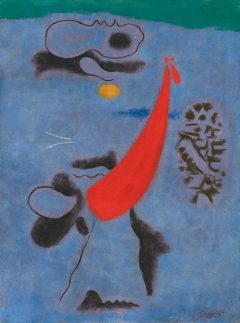Willi Baumeister
Tschun-Li
1949

Oil on hardboard on hardboard mounted
17 5/8 × 13 3/8 in on 20 1/2 × 16 1/8 in
Signed and dated »49« also signed, dated and titled again on the verso
Registered for the supplement to the Catalogue Raisonné of the artist ̛s paintings by Felicitas Baumeister and Peter Beye, Baumeister Archive Stuttgart, as no. 1514A
Private Collection Hesse; Villa Grisebach, Berlin (108th Auction, 30. May 2003, Lot 64); Private Collection Europe (2003-2023)
- Galerie Ludorff, "Neuerwerbungen Frühjahr 2024", Düsseldorf 2023
- Galerie Ludorff, "Neuerwerbungen Frühjahr 2024", Düsseldorf 2024, S. 10






